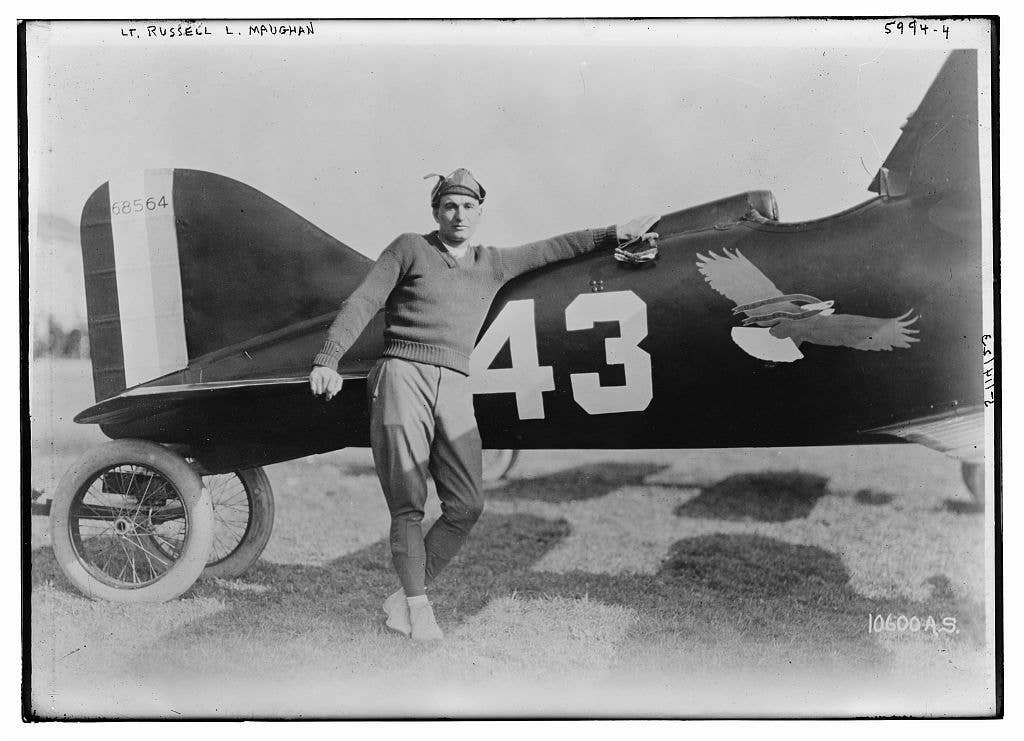
Pilot Russell Lowell Maughan, who won the Pulitzer Trophy in 1922, leans on a Curtiss R-6 Racer. National Aeronautic Association
For the first time in 97 years, a winner will be awarded the Pulitzer Trophy when the National Aeronautic Association launches a new 1,000-nautical-mile, cross-country air race for electric propulsion aircraft in 2022.
In a news release announcing the historic event, the NAA said the time is ripe for the opportunity: “The electric aircraft industry has been rapidly expanding in terms of technological readiness and the number of potential race contestants.”
The race will kick off on May 16, 2022, in Omaha, Nebraska, and will end on May 19, 2022, in Kitty Hawk, North Carolina. Registration will be limited to 25 pilots.
The Pulitzer Trophy started in 1920 as part of the National Air Races, according to the Smithsonian National Air and Space Museum. It was an effort by publishing magnates Joseph Jr., Ralph and Herbert Pulitzer to promote aviation. Over the course of six years, the trophy was awarded to pilots and airplanes with the fastest elapsed time during four laps over a 32-mile closed course. The last race took place in 1925 and the trophy currently resides at the Smithsonian National Air and Space Museum in Washington, D.C.
The NAA says the new race will be open to piloted aircraft of all types using zero-emission electric propulsion, including fixed-wing airplanes, helicopters or multirotor urban air mobility vehicles. Organizers say that because many of the potential competitors may be in a research and development phase and using experimental aircraft, the race will be a VFR-day-only event. The winner will be the pilot or crew with the fastest speed calculated from the cumulative flight time, not including time on the ground for maintenance, charging or overnight stays.
The cross-country format, rather than a closed-circuit speed event, was selected to emphasize electric aircraft range and reliability, in addition to speed, in a realistic operating environment.
“A cross-country race will require careful logistical planning from the race teams and highlight different electric propulsion technology choices and operational strategies such as rapid battery charging, whole battery changes and solar power augmentation to extend range,” the release said.
“As a long distance, multiday cross-country event open to all classes and types of electric aircraft, we have designed the Pulitzer Electric Aircraft Race to provide an open canvas for design innovations and be a flying expo for the electric aviation industry.”
Winners of the Pulitzer Trophy Race
1920: Corliss Champion Moseley, flying a Verville-Packard 600, 156.54 mph, Nov. 25, Mitchel Field, N.Y.
1921: Bert Acosta, flying a Curtiss, 176.76 mph, Nov. 3, Omaha, Neb.
1922: Russell L. Maughan, flying a Curtiss, 205.80 mph, Oct. 14, Detroit, Mich.
1923: Alford J. Williams, flying a Curtiss R2C1, 243.68 mph, Oct. 6, St. Louis, Mo.
1924: H.H. Mills, flying a Verville-Sperry, 216.55 mph, Oct. 4, Dayton, Ohio
1925: Cyrus Bettis, flying a Curtiss R3C1, 248.97 mph, Oct. 12, Mitchel Field, N.Y.
Source: The National Aeronautic Association
Race Rules
To view the complete rules for the race, click here.

Subscribe to Our Newsletter
Get the latest FLYING stories delivered directly to your inbox






